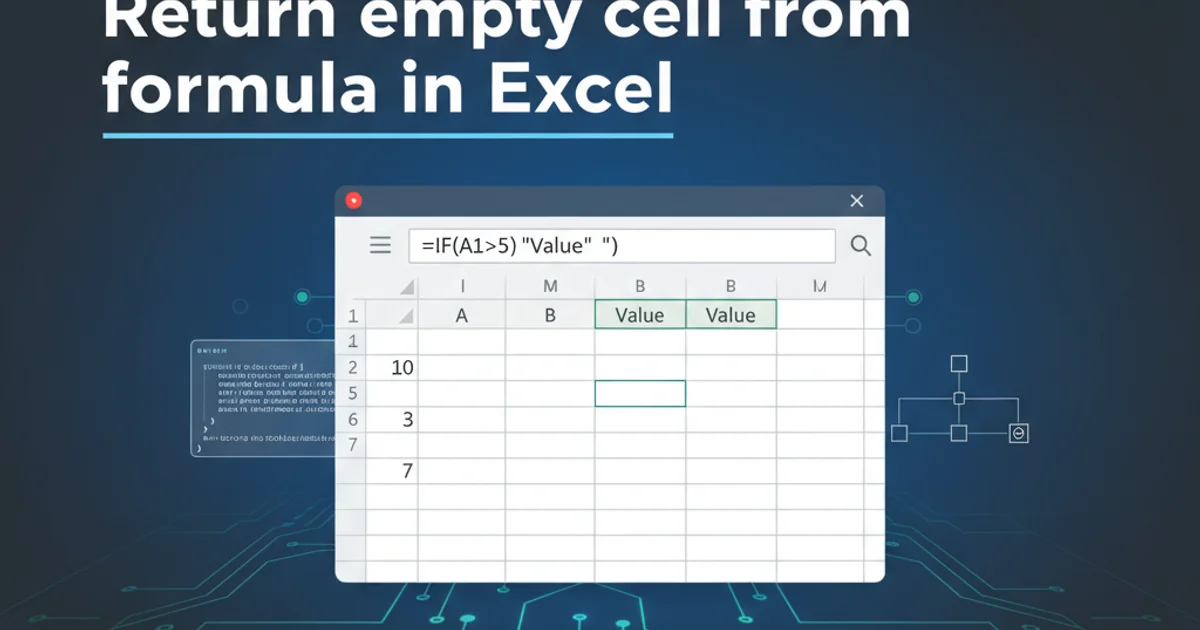Return empty cell from formula in Excel
Categories:
How to Return an Empty Cell from a Formula in Excel

Learn various methods to make Excel formulas return a truly empty cell or an empty string, enhancing readability and data processing.
When working with Excel formulas, you often need to return an empty cell under certain conditions. This can be crucial for maintaining clean spreadsheets, preventing errors in subsequent calculations, or simply improving readability. While Excel doesn't have a direct 'empty cell' function, there are several effective ways to achieve this, each with its own nuances. This article will explore the most common and robust methods, including using empty strings, the N() function, and conditional formatting.
Using Empty Strings "" for Blank Results
The most common and straightforward method to make a formula appear to return an empty cell is to use an empty string, represented by two double quotes "". While this doesn't create a truly empty cell (it contains a zero-length string), it looks blank and often behaves like an empty cell for many operations, especially text-based ones. However, it's important to note that an empty string is still considered text by Excel, which can sometimes affect numerical calculations.
=IF(A1="", "", B1*C1)
Example of using an empty string in an IF statement.
In this example, if cell A1 is empty, the formula returns "", making the cell appear blank. Otherwise, it performs the multiplication B1*C1. This approach is widely used due to its simplicity and visual effectiveness.
"" makes a cell look empty, it's technically a text value. If you need a truly numerical empty cell for calculations, consider alternative methods or ensure your downstream formulas can handle text values gracefully (e.g., using SUM which ignores text).Returning a Numerical Zero and Hiding It
Sometimes, you need the cell to be numerically empty (i.e., contain a zero) but still appear blank. This is particularly useful when the 'empty' state should be treated as zero in calculations without displaying the '0'. You can achieve this by returning 0 from your formula and then using either number formatting or Excel options to hide zero values.
=IF(A1="", 0, B1*C1)
Returning 0 instead of an empty string.
After applying this formula, you can hide the zeros using one of these methods:
1. Custom Number Format
Select the cell(s), right-click and choose 'Format Cells'. In the 'Number' tab, select 'Custom' and enter 0;-0;;@ in the 'Type' field. This format displays positive numbers, negative numbers, hides zeros, and displays text.
2. Excel Options
Go to File > Options > Advanced. Scroll down to 'Display options for this worksheet' and uncheck 'Show a zero in cells that have zero value'. This applies to the entire worksheet.
flowchart TD
A[Formula Condition Met?] -->|Yes| B["Return 0"]
A -->|No| C["Return Calculated Value"]
B --> D["Apply Custom Number Format (0;-0;;@)"]
D --> E["Cell Appears Blank (but is 0)"]
C --> F["Cell Shows Value"]
E & F --> G["Result in Spreadsheet"]Flowchart for returning zero and hiding it.
Using the N() Function for True Numerical Emptiness
The N() function in Excel converts non-numeric values to numbers, dates to serial numbers, and TRUE to 1. Crucially, it converts FALSE and error values to 0, and text to 0. While not directly returning an 'empty' cell, you can combine it with other logic to achieve a numerically empty state that appears blank, especially when dealing with conditional logic that might otherwise return text. However, N() itself doesn't return a blank; it returns 0 for text. A more direct approach for 'truly empty' is often desired, which leads back to "" for visual emptiness or 0 with formatting for numerical emptiness.
"" if your downstream formulas expect numerical values. Functions like SUM, AVERAGE, and COUNT will typically ignore "", but others like COUNTBLANK will count it as non-blank, and some mathematical operations might throw errors if not handled correctly.